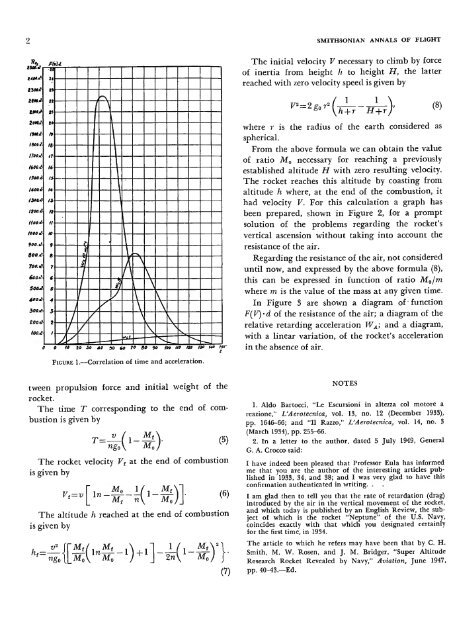FIRST STEPS TOWARD SPACE - Smithsonian Institution Libraries
FIRST STEPS TOWARD SPACE - Smithsonian Institution Libraries
FIRST STEPS TOWARD SPACE - Smithsonian Institution Libraries
You also want an ePaper? Increase the reach of your titles
YUMPU automatically turns print PDFs into web optimized ePapers that Google loves.
0 it 20 SO 40 90 60 10 BO 90 lot 110 Of 130 140 15V<br />
FIGURE 1.—Correlation of time and acceleration.<br />
tween propulsion force and initial weight of the<br />
rocket.<br />
The time T corresponding to the end of combustion<br />
is given by<br />
,= v (l MA<br />
The rocket velocity Vt at the end of combustion<br />
is given by<br />
„ r M0 i/. MtY<br />
Vt—v \n— — ( 1 — -r-jT-]<br />
f Mt n\ M0/_<br />
The altitude h reached at the end of combustion<br />
is given by<br />
ht= "go<br />
[MJ. Mt , \ . 1 1 /, Mt\<br />
(5)<br />
(6)<br />
(V)<br />
SMITHSONIAN ANNALS OF FLIGHT<br />
The initial velocity V necessary to climb by force<br />
of inertia from height h to height H, the latter<br />
reached with zero velocity speed is given by<br />
V* = 2g0r (_} LA<br />
\h + r H+r H+r)'<br />
where r is the radius of the earth considered as<br />
spherical.<br />
From the above formula we can obtain the value<br />
of ratio M0 necessary for reaching a previously<br />
established altitude H with zero resulting velocity.<br />
The rocket reaches this altitude by coasting from<br />
altitude h where, at the end of the combustion, it<br />
had velocity V. For this calculation a graph has<br />
been prepared, shown in Figure 2, for a prompt<br />
solution of the problems regarding the rocket's<br />
vertical ascension without taking into account the<br />
resistance of the air.<br />
Regarding the resistance of the air, not considered<br />
until now, and expressed by the above formula (8),<br />
this can be expressed in function of ratio M0jm<br />
where m is the value of the mass at any given time.<br />
In Figure 3 are shown a diagram of function<br />
F(V)'d of the resistance of the air; a diagram of the<br />
relative retarding acceleration WA; and a diagram,<br />
with a linear variation, of the rocket's acceleration<br />
in the absence of air.<br />
NOTES<br />
1. Aldo Bartocci, "Le Escursioni in altezza col motore a<br />
reazione," L'Aerotecnica, vol. 13, no. 12 (December 1933),<br />
pp. 1646-66; and "II Razzo," L'Aerotecnica, vol. 14, no. 3<br />
(March 1934), pp. 255-66.<br />
2. In a letter to the author, dated 5 July 1949, General<br />
G. A. Crocco said:<br />
I have indeed been pleased that Professor Eula has informed<br />
me that you are the author of the interesting articles published<br />
in 1933, 34, and 38; and I was very glad to have this<br />
confirmation authenticated in writing. .<br />
I am glad then to tell you that the rate of retardation (drag)<br />
introduced by the air in the vertical movement of the rocket,<br />
and which today is published by an English Review, the subject<br />
of which is the rocket "Neptune" of the U.S. Navy,<br />
coincides exactly with that which you designated certainly<br />
for the first time, in 1934.<br />
The article to which he refers may have been that by C. H.<br />
Smith, M. W. Rosen, and J. M. Bridger, "Super Altitude<br />
Research Rocket Revealed by Navy," Aviation, June 1947,<br />
pp. 40-43.—Ed.<br />
(8)

















